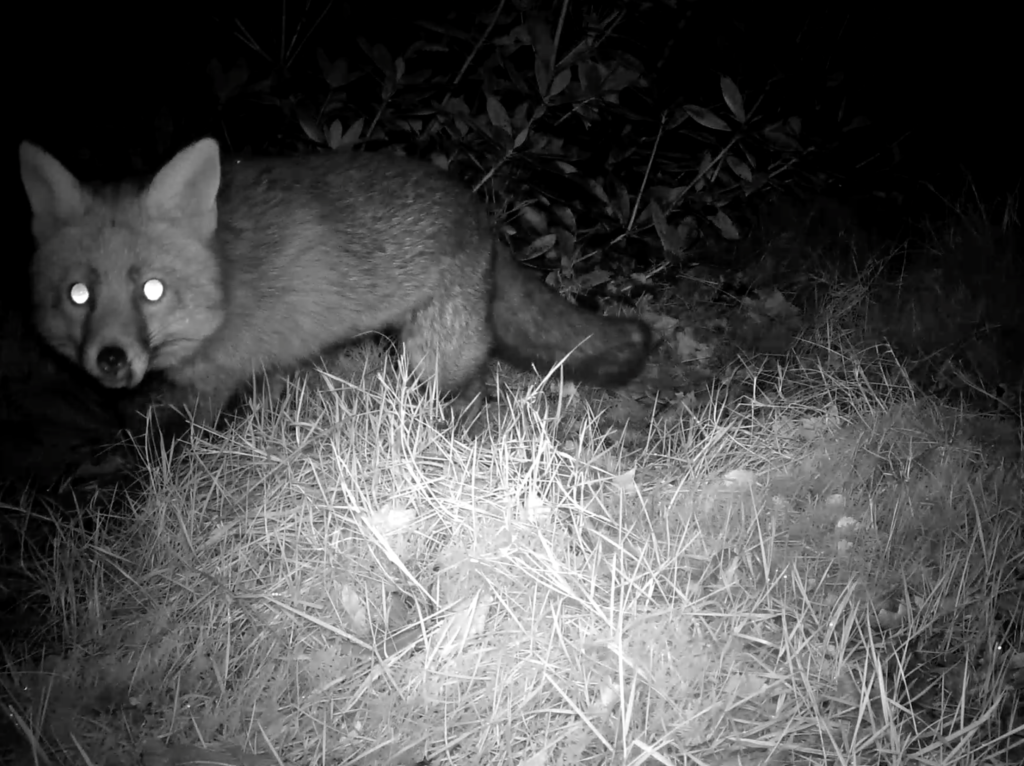At the back of our house the land rises steeply to a thicket of trees and shrubs, an unruly break between the row of suburban houses we are part of and a hardware store. We had been wondering what lived back there, hoping something did, but the wildlife is shy here in Belfast, so we installed a wildlife camera and waited to see.
Nocturnal co-inhabitants
And there she, or he, is. Silver eyes shine like dollar coins in the black and white image and then she steps elegantly through a bush and gone. The camera triggers at movement then records for twenty seconds. Sometimes she is already passing the camera, thick fur glistening with dew. Sometimes a branch is twitching, she is already gone. Other times she seems to pause and pose for our benefit.

On one shot, there is an insistent high mewling just off camera and she turns in front of the camera, inquisitive or worried, peering at us as we peer back later in our living room. At the edges of the day, when there is still enough light in the sky, we can see the magnificent red of her coat. There are young foxes too and to our delight, a badger digging energetically in the ground and a hedgehog lumbering its way over a tree root. The place positively swarms with life.

An urban fox encounter
I remember seeing my first fox in Melbourne, Australia. It was early evening in Footscray, a busy inner-city suburb with markets and restaurants, and Jon and I were on our second date. Walking, we turned the corner to the Vietnamese restaurant we planned to eat at and standing in the middle of the road was a fox. It turned to look at us, a beautiful foreigner, still among cars and rubbish and noise and concrete. It slipped away almost as soon as we registered it. We took it as a sign for our relationship—the strangeness of this encounter with wildness seemed to bode well.
Foxes are hated in Australia. Introduced by the colonials for hunting there are now millions of them covering the continent. A fox killed all my friend’s beloved chickens. They have been in Australia for 170 years now, multiple generations adapting to the climate and land. Yet I am delighted at having them here in my Belfast back yard.

The introduced and the native: an uneasy truce
I grew up in Christchurch, Aotearoa New Zealand, surrounded by some of the wildlife I see here. Bumblebees droned over mum’s flowers in the front yard. Hedgehogs snuffled under the hedge outside my bedroom at night. Rabbits scattered through the farmers’ fields as we wandered the neighbourhood. All brought by the settlers who came from the UK and quickly filled the place up with the plants, insects, birds and mammals they were familiar with. So many of these introductions were disasters for the local flora and fauna but to me, they were locals like myself. They belonged as much as I did.
We prioritise the rare over the common, the native over the introduced and this makes sense. The kākāpō, a large green flightless parrot, could not have survived without eradicating rats, cats, stoats, and ferrets, all introduced, from select islands. Still, we remain the greatest threat. Hedgehogs are now on the red list here in the UK, their preferred hedge homes vanishing into monoculture and fences.

Wildness is a kind of magic
I know that the fox in Footscray did not belong. But that moment of her looking at us, and we at her, was magic. It was an encounter with a creature vibrantly alive. I am grateful there is still wildlife, animals and birds who live their own lives, undomesticated, answering to their own rhythms. It is right they should be fearful of us and shy. I like that our encounters are fleeting, not limited by bars and cages. They remind me of the animal that I am and how all our lives are entangled, our fates linked together.
